For the visual types, I’ve summarized the tour in a video, and those interested in more detail can follow along next:
So what do we see?
- Two waterfalls, at the beginning of the tour,
- Cozy refuge, Graficart,
- Sljeme summit with TV tower,
- Medvednica Cave
- Bear Castle.
The Croatian capital really feels spring in April, as people are active in the streets. The 2020 earthquake has already been forgotten by the townspeople, but its traces are still visible in most of the buildings. Many houses are being destroyed: in some places only plaster has fallen off, in others the walls have fallen off. Houses have red, green and yellow stickers depending on how dangerous it is to live in.
Setting off on the tour, we walk through the pride of the people of Zagreb, the green horseshoe, that is, the series of gardens lined in a U-shape, and we pass by the equestrian statue of Jelasics, which originally pointed to Hungary with its sword, and then turned south, into the main square, which was allegedly Removed in the 1950s as part of the reverse Trojan horse movement. (According to urban legend, during the communist leadership, the statue was cunningly placed under a large cover, then carried in pieces so that the people of Zagreb would not notice the change, then there was a great surprise when the box was opened, the statue was nowhere to be found.)
The next morning, the tram and bus will take you to Vrapčanská, the edge of the residential area, in about half an hour, where the tour begins. Someone said goodbye to civilization by placing two white leather chairs at the edge of the forest, but since it will be too early to rest at the beginning of the path, we prefer to walk alongside them. We follow the path sign common in the Balkans: a red circle with a white dot drawn on the tree trunk. Since there are a total of 72 winding hiking trails in Medvednica, which is about the size of Mátra, the paths are numbered, and we will start on the fourth day.
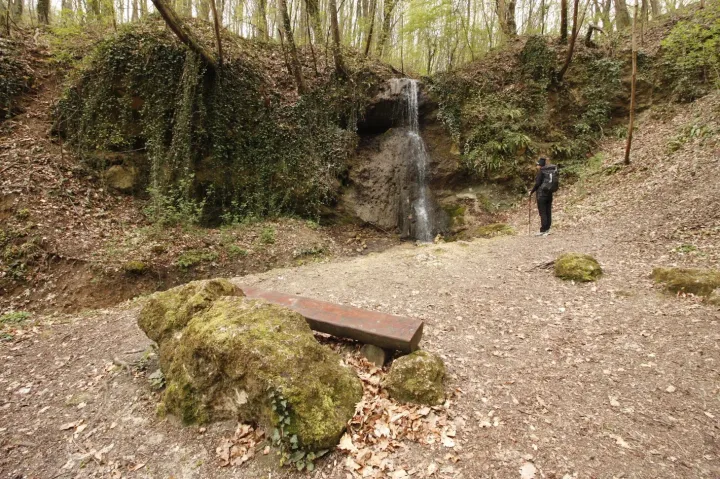
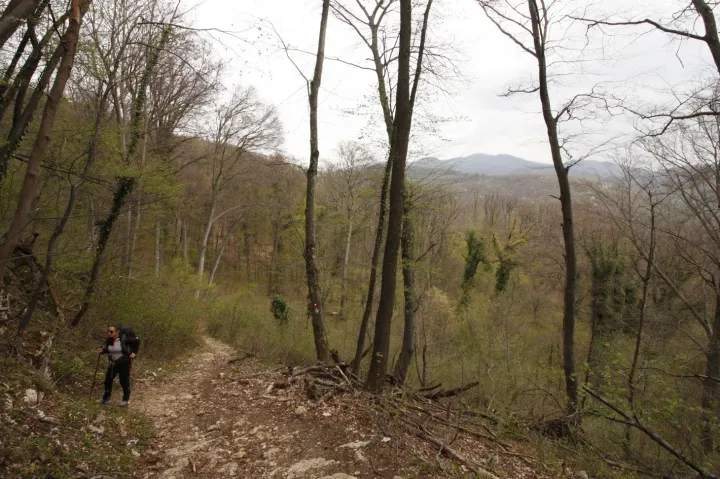
In the middle: Ferendol Waterfall, pictured below Sljeme in the distance – Image: Gábor Tenczer/Telex
We start immediately with two waterfalls: we can see the first waterfall after a 10-minute walk. The five-meter Slap Ferendol is reminiscent of the Ilona waterfall in Matra. The whole of Medvednica has something of a Mátra character: oak, beech, and a pleasant forest climate in the middle of the mountains. Three kilometers from the valley, a more majestic waterfall follows: Sopot.
The water cascades down from an intriguing 9-meter-high rock face: its sides seem to have been plowed by giant foot claws. A narrow wooden bridge takes you over the deep riverbed, and you can descend the steep bank all the way to the bathing area. After the waterfall, we exit the valley on a ridge that extends all the way to the upper region of the mountain range.
The path runs between oak trees and then beech trees. As we climb higher and higher, the weather gets colder. This can also be seen in the curtain of leaves: the forest is already green below, and the trees are still in their infancy. Partly that’s luck, you can see better from the hills and at some points you can see Sljeme peak and the TV tower gazing down on it. (By the way, Sljeme means spine.)
Just below the summit, at an altitude of 950 metres, we reach the Grafičar refuge. A real cozy mountain tourist home, with four euro bean soup and two euro apple pie. We’re not hungry yet, but we’re thirsty, so we drink thrush (a mix of light and brown beer). The house was built almost 70 years ago by the Grafičar Mountaineering Association and is one of the many tourist homes dotted in Medvednica, where you can also sleep. For us, still at the beginning of the sleep phase, up, up, we looked at a mountain dwelling house.
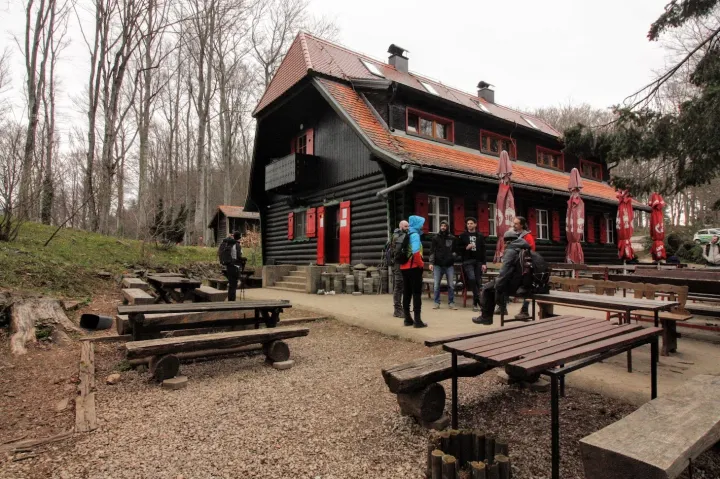
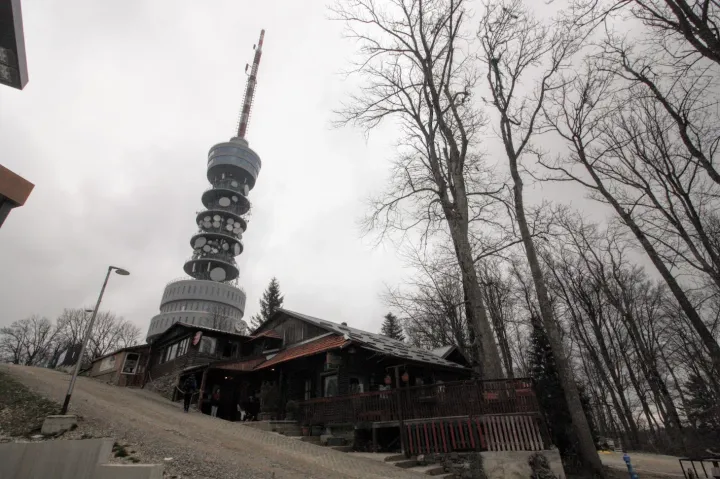
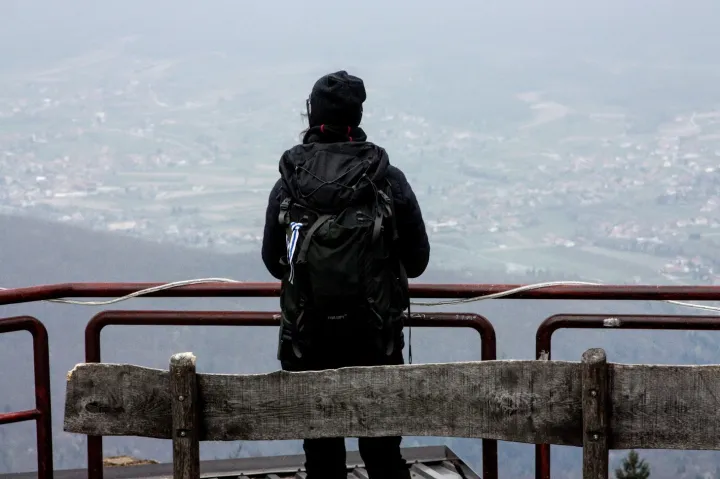
Shelter and Peak – Photo: Gábor Tenczer/Telex
There is still a long way to rest, we cross the top of the mountain and sit in the clouds, where only a few people walk. Down town, under cover of clouds, the weather is much better, and not many people feel like coming, although the trip can be made with a comfortable cable car. There is great skiing at the top of Sljeme in the winter, and a World Cup competition is held in January. The competition was called the Golden Bear, but was renamed the Snow Queen in honor of Croatia’s number one skier, Janica Kostelic. In April, we can still run into snow cannons every step of the way, and even wade through patches of snow. After the winter and before the summer the mountain hotels are still ringing with emptiness and most of the bars and buffets are closed too but I don’t mind if there are no crowds.
We will also pass the TV tower, which unfortunately cannot be climbed. Although a restaurant was planned in the tower built in 1973, there is space for it, and at one time it was possible to go up, but that time has passed: the building has been closed for a long time. This may be related to the fact that it was bombed by the Yugoslav army in 1991, and it took three months to recover it.
Our destination is the Medvednica Cave on the northern side of the mountain, which I marked on the map. The cave is four kilometers wide and 300 meters deep, we very much hope it was worth going there. The forest path is initially bordered by fir trees, and at lower levels more Mediterranean vegetation thrives on the karst rocky hills. The largest number of yew trees can be found here in Medvednica.
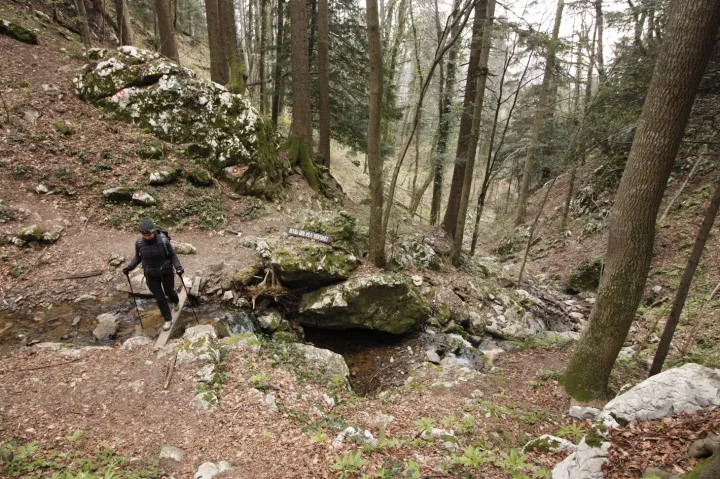
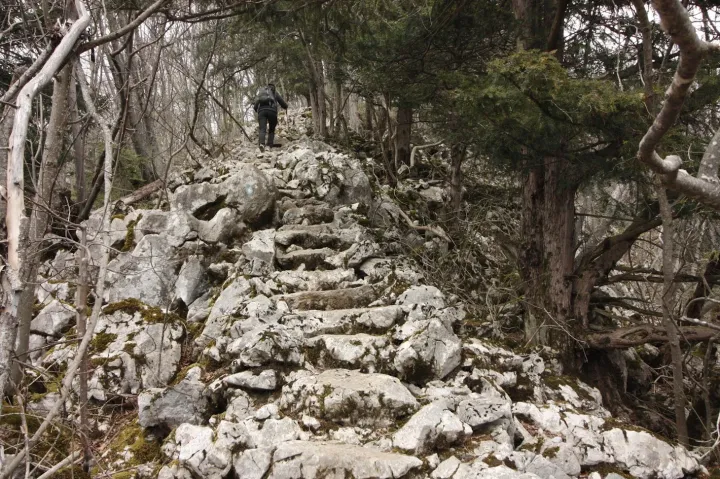

500 Degrees and its surroundings – Image: Gábor Tenczer / Telex
Even before the caves, the environment takes a promising turn: the rocky riverbed narrows, and you can cross the stream on a small bridge. Above, the entrance to the cave appears as a surprise, the shape of the part behind the opening is impressive. Thanks to the opening above, you can clearly see the 4-5 meter section that the road cuts towards the so-called 500 paces, but there is also a dark side branch that makes you curious. I take out my headlight and insert the oval horn.
I can go about 25 metres. It’s as if I’m trapped between the flaking, white, shimmering, round walls of rock, as if I’m in the esophagus and stomach of a dinosaur. My light falls on an overgrown grasshopper on the wall and my favorite scene from the comedy Tropic Storm jumps right in, when a beautiful grasshopper jumps into Ben Stiller’s eye. Fortunately, my grasshopper keeps quiet, and I don’t meet a wood troll in the cave, which the locals call Žirek.
The polished shapes of the rock erosion show that it was formed long ago by water flowing from the surface. The mountains here are karst and limestone, where rainwater finds its way more easily, but thanks to its varied geological history, Medvednica also has a kind of volcanic rock. Moreover, the movements of the earth’s crust around the mountain range are not over yet, and it is enough if we think only of the recent earthquakes.

Medvednica Cave – Image: Gábor Tenczer / Telex
Upon exiting the hatch, a rocky path follows, heading towards the mountain. The path, sometimes turned into a railing, is provided by metal hand-grips hammered into the rock. The stones were carved in the 1950s by journalist and climber Vladimir Horvat, lover of Medvednica, so that they would be easier to climb. The rocky path was named Horvat 500 steps (Horvatovih 500 stupa) after him, which many consider the most beautiful path in the mountains.
On the normal-looking stone steps, we pass through two more openings to shaft-like caves, which we can only look into, and the final destination is a large frog-shaped rock, Moj Naklon, in the center of which two interlocking green hearts are drawn. Stairs lead down a mountain path, where we start again towards the top of the mountain, where our lodging awaits.
The next morning we get an explanation for why there is still snow in Sljem in April: it’s -1 degrees, and the trees are covered in white with hoarfrost. The peak is more hazy than the day before, so the panorama has to be abandoned. We passed a small chapel in the woods where Mass was being held.
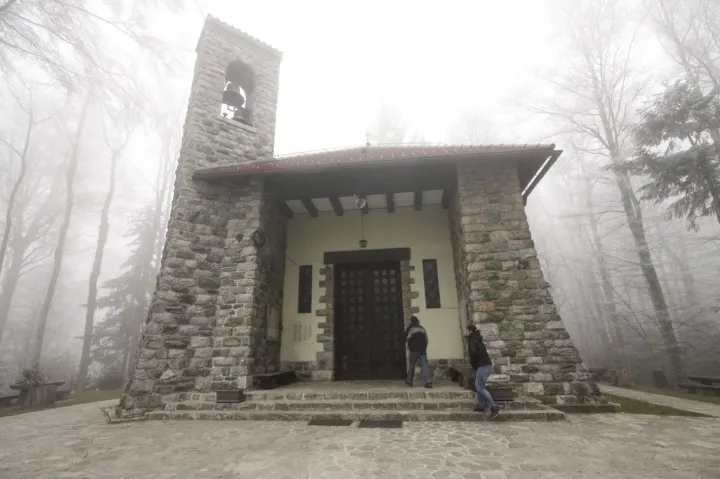
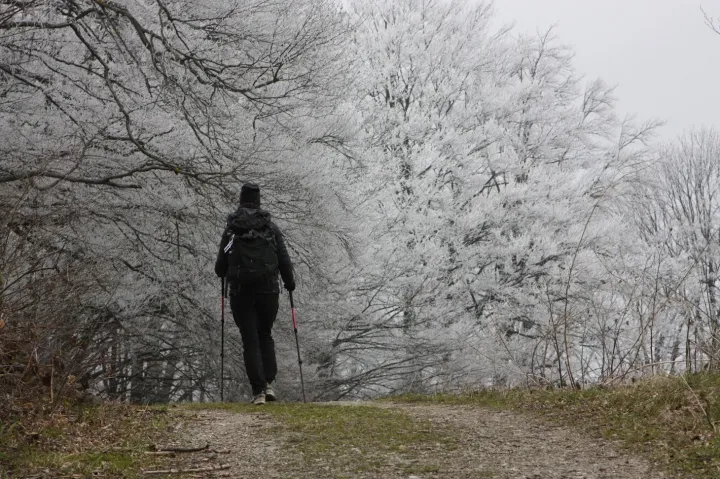
The chapel and the forest above – Image: Gábor Tenczer / Telex
As we descend towards our next destination, Medvevár, emerging from the clouds, Zagreb finally appears below us, but the icy frost is still ringing on the crown of trees. In the castle, very good weather awaits us, but unfortunately we find the gates locked. However, I would have been interested in Medvegrad, which is still in good shape, and has many Hungarian aspects. On March 27, 1472, Janos Pannonias, humanist poet, bishop of Pécs, supporter and later opponent of King Matthias, died here while fleeing. It was here that the Hungarian, Croatian, German and Czech queen Celi Borbala lived, the second wife of King Sigismund, about whom many legends have survived.
The main crime of Borbala Selye, referred to as the Black Queen, was that she had deceived the king, but they could not prove it, so Zsigmund eventually forgave her. Nevertheless, she remained in the public consciousness as a guilty woman, and more and more serious witches began to be attributed to her, for example, that her black raven gouged out the eyes of her angry people at her command. The woman eventually moved to the Czech Republic and died there.


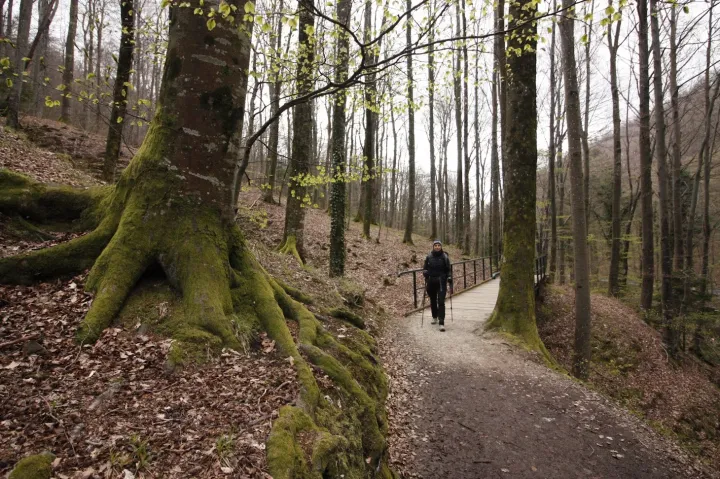
Above: Medvevár – Photo: Gábor Tenczer/Telex
The castle got its name from the bears, just like the mountain range, but there is no need to fear that the hiker will meet the bears here, because they have been dead for centuries. It is interesting that the name Medvednica appears in written form for the first time in the Golden Bull, and in it IV. The Croatian-Hungarian King Béla donates the mountain to Gradic in Zagreb.
The city limits are not far from the castle, we go down a built up forest road. As we get closer, more and more hikers appear in the area, and finally we enter the Šestina area, where we take a bus to the center of Zagreb.
Zoomable map of the walking path:
In the end, the tour turned out to be more interesting than we expected. Obviously the whole 25km long with 1500m difference in elevation looks more like a 2 days trek but if you don’t have much time you can use the cable car to go to the caves and the two waterfalls and the castle is also easily accessible by car or public transport.
You can comment on the article and recommend other good places Great magazine! Also on his Facebook pageEven like the page if you haven’t already! Questions and tips can also come here.
Other tours in the area:












































